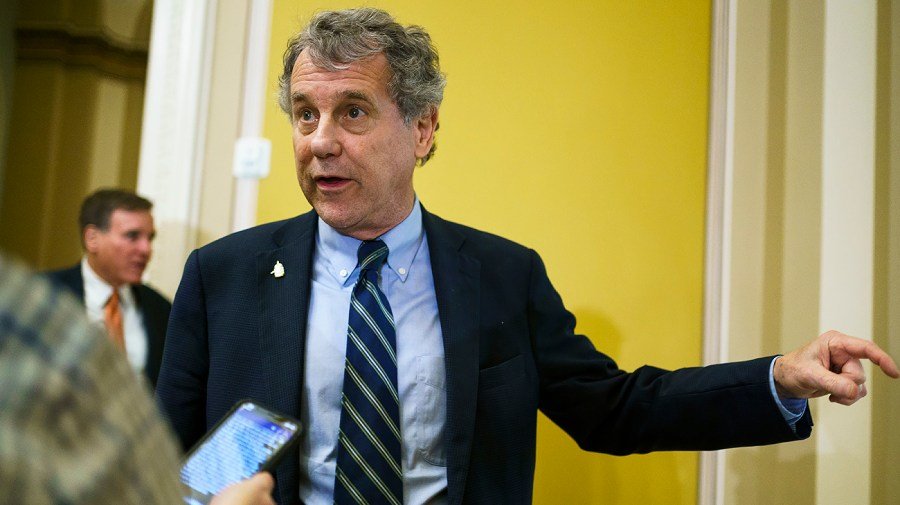Business
Senators push to pass cannabis banking bill after marijuana rescheduling on September 14, 2023 at 10:00 am Business News | The Hill

A bipartisan coalition of senators behind a cannabis banking bill is pushing for a markup and working to clear key hurdles on both sides of the aisle to lock down support.
As advocates work to drum up momentum for the Secure and Fair Enforcement (SAFE) Banking Act, some proponents in the upper chamber have expressed hopes the bill could advance out of committee in the coming weeks.
“We hope to be able to announce something in the next few days,” Senate Banking Committee Chairman Sherrod Brown (D-Ohio) told reporters this week.
The SAFE Banking Act would give federally regulated banks and credit unions legal cover to take cannabis dispensaries and growers as customers. Financial institutions have been hesitant to serve state-legal cannabis businesses because of the federal ban on the drug.
Democrats say excitement has been building after the Department of Health and Human Services (HHS) recommended that marijuana, which is classified as a Schedule I drug, be moved to the Schedule III category.
“What happened on Schedule III was good, another potential breakthrough,” Sen. Ron Wyden (D-Ore.) said, adding: “We’re moving to finally end the days of ‘Reefer Madness.’ The federal government just been behind on pot.”
Sen. Mark Warner (D-Va.) called the HHS decision “a recognition of reality.”
“The idea that you’ve got marijuana illegal in over half the states, and yet at the federal level, it’s still categorized in the same category as heroin, it seems a bit out of touch with the science,” Warner said.
But as discussions continue, Brown and other negotiators say there is still some work to do before they can lock down necessary backing from conservatives and progressives to secure passage.
“There’s still some outlying issues, minor ones, but we hope to get people on board and get a strong vote,” Brown said.
While 38 states and the District of Columbia have legalized cannabis for medical or recreational use, the possession, distribution or sale of cannabis is still illegal at the federal level. As a result, legally operating cannabis businesses are often denied access to banks.
Proponents of the bill say the SAFE Banking Act would help legally operating businesses avoid the headaches and safety risks of dealing only in cash without affecting the legal status of cannabis beyond states where it’s legal.
But despite passing the House several times in recent years, the bill has faced a bumpy road in the Senate, where it needs at least 60 votes to clear the upper chamber. Both Republicans and Democrats have expressed objections to the bill, reflecting sharp partisan divides over cannabis use and regulation beyond the financial sector.
Senators had previously sought to pass the bill as part of the larger government funding omnibus approved late last year, but talks fell apart after it faced staunch opposition from GOP leadership.
Other rank-and-file Republicans have also been resistant to signing the bill backed strongly by marijuana advocates given their personal opposition to cannabis use.
“I don’t know if we got the votes. At least they don’t have my vote at this stage of the game,” Sen. Mike Rounds (R-S.D.), who also sits on the Banking Committee, told The Hill this week.
“I don’t think making access to marijuana at this stage of the game is necessarily helpful,” he added.
Republicans have also raised concerns about preventing banks from cracking down on other politically controversial industries.
“I think there’s a desire to sort of level the playing field, if you will, between things like hemp and CBD, and then there’s been some desire to — I, for one, would like to see the same premise applied obviously to banks and things like Operation Choke Point,” Sen. Kevin Cramer (R-N.D.) told The Hill, referring to the Obama-era scrutiny of bank transactions with firearms businesses.
“Try to eliminate some of that nonsense,” he said. “I think there is a discussion ripe for some compromise and some deal-making.”
Democratic negotiators say talks are still ongoing on the issue, but Sen. Jack Reed (D-R.I.), a key player in those discussions, told The Hill on Tuesday that both sides are “making progress.”
While timing around when the bill will see markup remains unclear, Sen. Steve Daines (Mont.), a key Republican in talks, told The Hill recently that he’s hopeful it will happen “sometime in September.”
“I think there’s a chance to get a markup done,” he said.
While an overwhelming majority of Senate Democrats back the bill, progressives have been wary to vote on a bill that would boost cannabis business without addressing federal drug laws.
“Robust conversations are going on that makes me very hopeful that we can get SAFE done, we can get some equity issues,” Sen. Cory Booker (D-N.J.) told The Hill on Tuesday.
Andrew Freedman, executive director of the Coalition for Cannabis Policy, Education, and Regulation, told The Hill that there are advocates who don’t believe the SAFE Banking Act should be the first cannabis bill passed by Congress.
“I think we’d rather see it be something around decriminalization. So that is definitely going be a tension all the way through with SAFE Act,” Freedman said.
Some progressives have floated adding on the Harnessing Opportunities by Pursuing Expungement (HOPE) Act, a bill offered by Reps. Dave Joyce (R-Ohio) and Alexandria Ocasio-Cortez (D-N.Y.) that seeks to help states expunge cannabis convictions.
Pressed about HOPE this week, Booker wouldn’t get specific when discussing potential add-ons for the bill, but he stressed the need for more equity in the cannabis space.
“My pillars: opening up the banking industry, creating more equity opportunities for women and minorities to have access to that banking industry, and trying to get some social criminal justice things done,” he said.
Even so, the addition of social and criminal justice measures to the SAFE Banking Act could cost support from anti-cannabis Republicans and other groups who prefer to focus on the business-oriented aspects.
The American Bankers Association (ABA) is among the prominent noncannabis groups supporting the legislation.
“We’re optimistic that we will see movement on the SAFE Banking Act in the coming weeks and urge the Senate to get this bipartisan, commonsense legislation that will enhance public safety across the finish line,” Jeff Sigmund, an ABA spokesperson, told The Hill in a written statement.
Because the possession, distribution or sale of cannabis is still illegal at the federal level, the industry is largely unbanked for fear of federal sanctions, as the ABA pointed out in a letter to Congress in May expressing its support for the bill.
This is a banking bill, not a cannabis bill, which makes it more politically palatable for some lawmakers, several lobbyists told The Hill.
“Because it deals specifically with the financial institutions, rather than the cannabis businesses, it feels — for lack of a good word — safe for a lot of these members,” David Mangone, director of policy at a federal cannabis advocacy firm called The Liaison Group told The Hill in a phone interview.
Business, Senate A bipartisan coalition of senators behind a cannabis banking bill is pushing for a markup and working to clear key hurdles on both sides of the aisle to lock down support. As advocates work to drum up momentum for the Secure and Fair Enforcement (SAFE) Banking Act, some proponents in the upper chamber have expressed…
Business
Why 9 Million Americans Have Left

The Growing American Exodus
Nearly 9 million Americans now live outside the United States—a number that rivals the population of several states and signals a profound shift in how people view the American dream. This mass migration isn’t confined to retirees or the wealthy. Thanks to remote work, digital nomad visas, and mounting pressures at home, young professionals, families, and business owners are increasingly joining the ranks of expats.

Rising Costs and Shrinking Wallets
Living in the US has become increasingly expensive. Weekly grocery bills topping $300 are not uncommon, and everyday items like coffee and beef have surged in price over the last year. Rent, utilities, and other essentials also continue to climb, leaving many Americans to cut meals or put off purchases just to make ends meet. In contrast, life in countries like Mexico or Costa Rica often costs just 50–60% of what it does in the US—without sacrificing comfort or quality.
Health Care Concerns Drive Migration
America’s health care system is a major trigger for relocation. Despite the fact that the US spends more per person on health care than any other country, millions struggle to access affordable treatment. Over half of Americans admit to delaying medical care due to cost, with households earning below $40,000 seeing this rate jump to 63%. Many expats point to countries such as Spain or Thailand, where health care is both affordable and accessible, as a major draw.

Seeking Safety Abroad
Public safety issues—especially violent crime and gun-related incidents—have made many Americans feel unsafe, even in their own communities. The 2024 Global Peace Index documents a decline in North America’s safety ratings, while families in major cities often prioritize teaching their children to avoid gun violence over simple street safety. In many overseas destinations, newly arrived American families report a significant improvement in their sense of security and peace of mind.
Tax Burdens and Bureaucracy
US tax laws extend abroad, requiring expats to file annual returns and comply with complicated rules through acts such as FATCA. For some, the burden of global tax compliance is so great that thousands relinquish their US citizenship each year simply to escape the paperwork and scrutiny.
The Digital Nomad Revolution
Remote work has unlocked new pathways for Americans. Over a quarter of all paid workdays in the US are now fully remote, and more than 40 countries offer digital nomad visas for foreign professionals. Many Americans are leveraging this opportunity to maintain their US incomes while cutting costs and upgrading their quality of life abroad.

Conclusion: Redefining the Dream
The mass departure of nearly 9 million Americans reveals deep cracks in what was once considered the land of opportunity. Escalating costs, inaccessible healthcare, safety concerns, and relentless bureaucracy have spurred a global search for better options. For millions, the modern American dream is no longer tied to a white-picket fence, but found in newfound freedom beyond America’s borders.
Business
Will Theaters Crush Streaming in Hollywood’s Next Act?

Hollywood is bracing for a pivotal comeback, and for movie lovers, it’s the kind of shake-up that could redefine the very culture of cinema. With the freshly merged Paramount-Skydance shaking up its strategy, CEO David Ellison’s announcement doesn’t just signal a change—it reignites the passion for moviegoing that built the magic of Hollywood in the first place.

Theatrical Experience Roars Back
Fans and insiders alike have felt the itch for more event movies. For years, streaming promised endless options, but fragmented attention left many longing for communal spectacle. Now, with Paramount-Skydance tripling its film output for the big screen, it’s clear: studio leaders believe there’s no substitute for the lights, the hush before the opening credits, and the collective thrill of reacting to Hollywood’s latest blockbusters. Ellison’s pivot away from streaming exclusives taps deep into what unites cinephiles—the lived experience of cinema as art and event, not just content.
Industry Pulse: From Crisis to Renaissance
On the financial front, the numbers are as electrifying as any plot twist. After years of doubt, the box office is roaring. AMC, the world’s largest theater chain, reports a staggering 26% spike in moviegoer attendance and 36% revenue growth in Q2 2025. That kind of momentum hasn’t been seen since the heyday of summer tentpoles—and it’s not just about more tickets sold. AMC’s strategy—premium screens, with IMAX and Dolby Cinema, curated concessions, and branded collectibles—has turned every new release into an event, driving per-customer profits up nearly 50% compared to pre-pandemic norms.
Blockbusters Lead the Culture
Forget the gloom of endless streaming drops; when films like Top Gun: Maverick, Mission: Impossible, Minecraft, and surprise hits like Weapons and Freakier Friday draw crowds, the industry—and movie fans—sit up and take notice. Movie-themed collectibles and concession innovations, from Barbie’s iconic pink car popcorn holders to anniversary tie-ins, have made each screening a moment worth remembering, blending nostalgia and discovery. The focus: high-impact, shared audience experiences that streaming can’t replicate.
Streaming’s Limits and Studio Strategy
Yes, streaming is still surging, but the tide may be turning. The biggest franchises, and the biggest cultural events, happen when audiences come together for a theatrical release. Paramount-Skydance’s shift signals to rivals that premium storytelling and box office spectacle are again at the center of Hollywood value creation. The result is not just higher profits for exhibitors like AMC, but a rebirth of movie-going as the ultimate destination for fans hungry for connection and cinematic adventure.

Future Forecast: Culture, Community, and Blockbuster Dreams
As PwC and others warn that box office totals may take years to fully catch up, movie lovers and industry leaders alike are betting that exclusive theatrical runs, enhanced viewing experiences, and fan-driven engagement are the ingredients for long-term recovery—and a new golden age. The Paramount-Skydance play is more than a business move; it’s a rallying cry for the art of the theatrical event. Expect more big bets, more surprises, and—finally—a long-overdue renaissance for the silver screen.
For those who believe in the power of cinema, it’s a thrilling second act—and the best seat in the house might be front and center once again.
Business
Why Are Influencers Getting $7K to Post About Israel?

Influencers are being paid as much as $7,000 per post by the Israeli government as part of an expansive and sophisticated digital propaganda campaign. This effort is designed to influence global public opinion—especially among younger social media users—about Israel’s actions in Gaza and to counter critical narratives about the ongoing humanitarian situation.

How Much Is Being Spent?
Recent reports confirm that Israel has dedicated more than $40 million this year to social media and digital influence campaigns, targeting popular platforms such as TikTok, YouTube, and Instagram. In addition to direct influencer payments, Israel is investing tens of millions more in paid ads, search engine placements, and contracts with major tech companies like Google and Meta to push pro-Israel content and challenge critical coverage of issues like the famine in Gaza.
What’s the Strategy?
- Influencer Contracts: Influencers are recruited—often with all-expenses-paid trips to Israel, highly managed experiences, and direct payments—to post content that improves Israel’s image.
- Ad Campaigns: State-backed ad buys show lively Gaza markets and restaurants to counter global reports of famine and humanitarian crisis.
- Narrative Management: These posts and ads often avoid overt propaganda. Instead, they use personal stories, emotional appeals, and “behind the scenes” glimpses intended to humanize Israel’s side of the conflict and create doubt about reports by the UN and humanitarian agencies.
- Amplification: Paid content is strategically promoted so it dominates news feeds and is picked up by news aggregators, Wikipedia editors, and even AI systems that rely on “trusted” digital sources.
Why Is This Happening Now?
The humanitarian situation in Gaza has generated increasing international criticism, especially after the UN classified parts of Gaza as experiencing famine. In this environment, digital public relations has become a primary front in Israel’s efforts to defend its policies and limit diplomatic fallout. By investing in social media influencers, Israel is adapting old-school propaganda strategies (“Hasbara”) to the era of algorithms and youth-driven content.
Why Does It Matter?
This campaign represents a major blurring of the lines between paid promotion, journalism, and activism. When governments pay high-profile influencers to shape social media narratives, it becomes harder for audiences—especially young people—to distinguish between authentic perspectives and sponsored messaging.

In short: Influencers are getting $7,000 per post because Israel is prioritizing social media as a battleground for public opinion, investing millions in shaping what global audiences see, hear, and believe about Gaza and the conflict.

 Business3 weeks ago
Business3 weeks agoDisney Loses $3.87 Billion as Subscription Cancellations Surge After Kimmel Suspension

 Entertainment3 weeks ago
Entertainment3 weeks agoWhat the Deletion Frenzy Reveals in the David and Celeste Tragedy

 Entertainment4 weeks ago
Entertainment4 weeks agoABC Suspends ‘Jimmy Kimmel Live!’ Indefinitely After Kirk Remarks

 Entertainment3 weeks ago
Entertainment3 weeks agoExecutive Producer Debut: How Celia Carver Created Festival Hit ‘Afterparty’

 Business4 weeks ago
Business4 weeks agoThe Rise Of Bullsh*t Jobs: Why Gen Z Hates Work

 Health3 weeks ago
Health3 weeks agoRussia Claims 100% Success With New mRNA Cancer Vaccine

 Film Industry4 weeks ago
Film Industry4 weeks agoCan Movie Theaters Steal the Show from Streaming?

 News4 weeks ago
News4 weeks agoBody of Missing Teen Found in Tesla Linked to Musician D4vd




























